How Onion Retailers in Bihar’s Bettiah Town Are Braving Price Spike
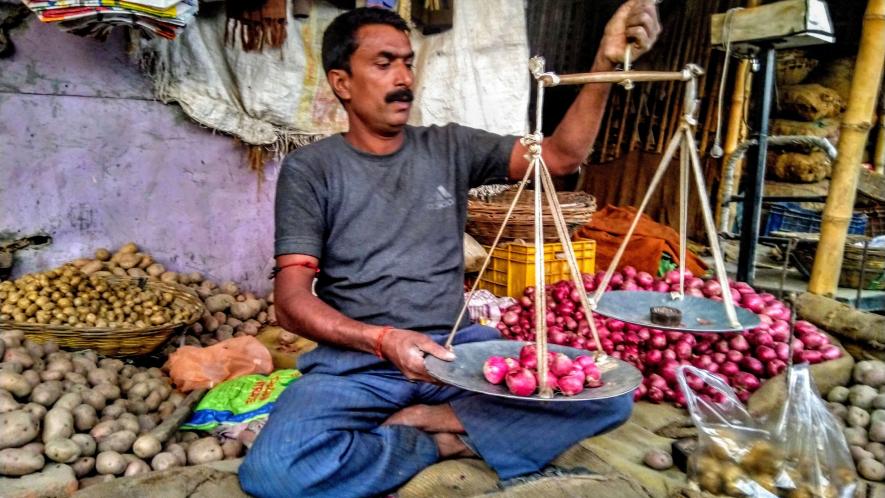
Markandey Gupta is financing his family of five members and education of three children with the income from selling potatoes and onions.
Bettiah (Bihar): “Who told you that we are profiteering?” says Md. Aashif, in his early twenties, when asked about the benefit onion retailers are said to be making in the garb of price hikes. “Onions are rotting. We bought 20 sacks– -each weighing 45 kg– of onions yesterday, but we are unable to get rid of even a single sack,” he adds, pointing at wasted onions lying around. “You will get at least 2/3 kilogram of waste in a sack,” he says. This is roughly an error of 4% for Aashif’s stall, jointly managed by three people -- Md. Sahabuddin and Ankur Kumar are other partners in the business.
The problem of rotten onions is uniform across the retail markets, such as Meena Bazaar in Bettiah town of Bihar, among many others. There are some 100 retailers who sell onions in a small stretch of one kilometre. Their problems are largely temporal and similar. Moreover, there are personal constraints, as most of them belong to marginalised communities. Along with the structural weakness and pressures of an unorganised market, their personal financial growth stands disrupted.
NewsClick spoke with some retailers– the innate component of vegetable marketing hierarchy– to understand the crisis following the huge spike in onion prices.
Md. Sahabuddin says he bought the onions at the rate of Rs. 95/kg from the wholesaler. Now, after adding the transportation cost, the (adjusted) cost price, he says, has reached up to Rs. 100/kg, while the retail price on the day this reporter visited the market was Rs. 110/kg.
“Making a profit of Rs. 10 on one kg of vegetable is certainly fruitful […] but the customer should buy it. With sky-high rise in prices, the demand for onions has fallen drastically,” says Sahabuddin, adding that he does not carve onions from his personal stock for fear it would cost him as a customer too. “As you see, we do not have storage arrangements. We are small retailers. We will somehow have to sell the stockpile before it gets destroyed […].”
Hamarak Hussain, a sexagenarian, has a stall a few meters away from Sahabuddin’s, and faces a similar situation. He says he bought 50 kg of onions but could sell only 2 kg till now; also, 2 kg in the sack was rotten.
“The wholesaler doesn’t pay to compensate for these losses. One has to buy a whole sack,” he says, adding that whatever the loss is the buyer’s.
Hussain recapitulates the trend of cost price against selling price: “A week ago, we bought onions at Rs. 75 (per kg), they were sold at Rs. 80 (per kg). Earlier, it was Rs. 50/kg against Rs. 60/kg. Here, the minimum selling price we reached within a year was Rs. 20.” The reason behind giving out these figures was the fact that Hussain wanted to reiterate that he made hardly any money either way.
“We retailers rarely make money because of these price hikes. We do not fix prices, which are manipulated by people much higher in hierarchy. A mere profit of Rs. 5-11/kg is what we would achieve if had good sale,” he adds.
Samser Alam, Hamarak’s 15-years-old son, helps his father manage the shop whenever he gets free. Samser, who studies in Class 8 at Amna Urdu High School, says: “My father has grown old, so sometimes I come here.”
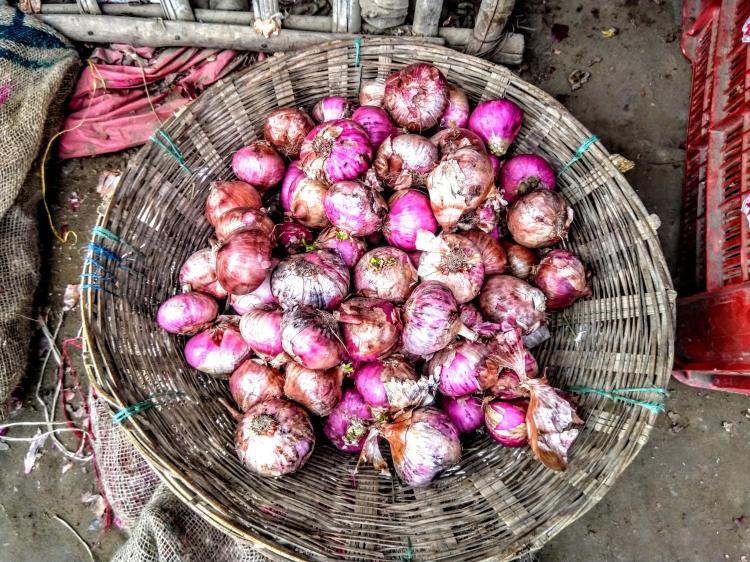
5 kg of rotten onions at Samser Aliâs stall.
He adds: “There has been no drastic variation in the prices of potato—sold at an average rate of Rs. 20 kg throughout the year—but fluctuations in the prices of onion have affected us. What would we make by selling 2 kg of onions after spending hours?”
Each shop is open from 10 a.m. to 9 p.m.; most of these shops have joint-bamboo enclosure with flimsy roof covers to protect the vegetables from moisture. In fact, these shops are street vending units built on the encroached part of a footpath. For that, these people pay a daily fee of Rs. 10 to the contractor.
Retailers were evicted earlier this year from this location by the district administration. However, they re-established themselves within 10 days. More so, retailers say that this is temporary measure, and “this shall not hold as district medical facility is to be constructed soon on this part of land.” They seem resigned to relocating themselves thereon.
Samser’s cousin, Md. Amanullah, 40, has only two items on sale, i.e. onions and potatoes. This, in fact, is common for all onion retailers, who rarely sell any other vegetables. This further lowers the sale-cap for retailers, limiting their daily earning between Rs. 300 and Rs. 500. Amanullah says he puts the rotten onions to personal use.
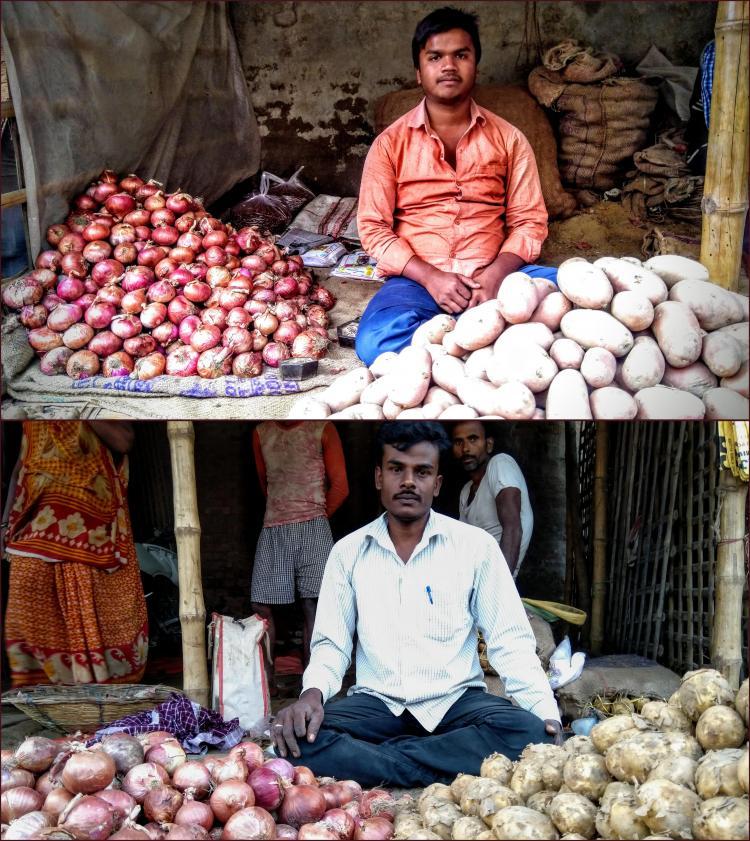
Samser Alam [top] and Sahabuddin could not sell even a single sac of onion, roughly half a quintal.
A resident of Jamdar Tola locality, Amanullah says onion crops have been almost destroyed in this region following incessant rains that wreaked havoc a few months ago. He is landless; he produces profitable vegetables on borrowed land. For three katta of land, he paid Rs. 3,600 -- for both Rabi and Kharif seasons. While Kharif crops were damaged, Amanullah is pinning hopes on the Rabi crops, as he has planted cauliflower [probably to be sold in February]. Until then, he will only depend on retail.
As in the case of most retailers here, the stall is the only source of income for Amanullah’s family of eight members. He has taken an informal loan of Rs. 20,000 at a monthly interest rate of 3%, which, he adds, is quite difficult to repay this year. This hefty amount, he says, was incurred to pay for medical expenses for his mother’s treatment.
This year, Amanullah earned a maximum daily profit of Rs. 600 and a minimum of negative gains, that is, he had to sell vegetables below the cost price mark. “This is not an easy business as one would think […],” he adds.
Samser Ali, 45, says he lowers prices if someone buys onions in paseri units. Paseri, a unit of local weight measurement, is equivalent to 5 kg. If Samser sells 1 kg of onion for Rs 110, he would sell a paseri for Rs. 520. Asked why he does so, he says: “The town is abuzz with rumours that prices are going to fall as some low-cost onions are going to flood markets soon. That is why, we are neither intaking huge stocks nor are we thinking of making huge gains.”
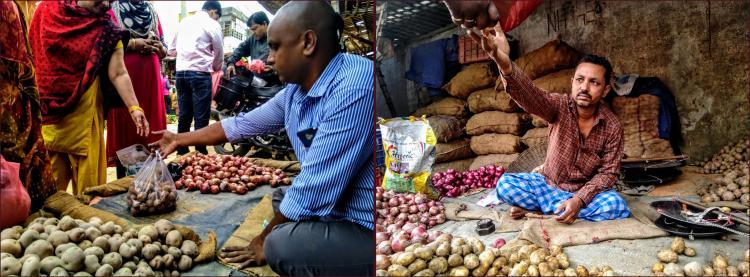
Md. Amanullah and Samser Ali [right] at their shops.
Talking about the high prices, Ali says: “Customers are buying onions as if they are buying precious jewellery. Actually, rarely is anyone buying a kg of onions […].” Thus, the nominal gains we make are dependent on potatoes, he says, adding that 12 members of his family are dependent on these petty gains.
“My mother and elder brother are mentally unstable. Do you think that that doctors at the government hospital listen to the poor like us? I cannot leave them alone; somehow, I am pulling it off,” continues Ali, a landless retailer.
He says he is even ready to take more loans for the education of his children. “I don’t want them to fall in line with my business”, he adds. Ali’s eldest child recently finished his secondary level and is enrolled for intermediate education in a local college.
None of these retailers want their kids to join their business because of the prevalent uncertainty. Ali, who has been in this profession since the past 30 years, says he sold 20 kg of onions out of the 45 kg sack, adding that he will sell 5 kg of rotten onions at Rs. 60/kg if anybody turns up.
Retailers we talked to also said that local restaurants were also badly affected by the onion price hike as, there is no substitute to onions when it comes to spicy food, especially non-vegetarian curries.
Many of these retailers are from the town area while some of them cycle several miles every day. Shrivastay Singh, a sexagenarian, resides in a village called Balua Rampurwa, 10 km away. Each day, he leaves for the procurement centre at 9 a.m and reaches home at 10 p.m.
One of the major issues these retailers are facing is the lack of an efficient procurement centre. For a population of over a lakh, there is a single procurement centre, called Bazar Samiti. This emboldens the might of wholesalers and big traders who channelise most of the vegetables. This concentration of power in a few hands not only disturbs the prospects of retailers, but also concomitantly allows parasitic powerholders to act as their redeemers.
The mechanism is simple: As the rates go higher, small retailers with small capital are unable to buy onions, or, for that matter, any other costly vegetable stock. That’s when wholesalers start providing informal loans to vegetable sellers to allow them to buy their own highly priced stock. This easily doubles their profit.
Retailers in Meena Bazar confirm this modus operandi, but feel helpless in a privatised market with no state intervention. One end of this privatised market allows retailers to enhance profits as they wish, however, lack of sufficient capital [including absence of easy loan facility for small businessmen, like vegetable vendors] obstructs the business, leaving them with no option but to suffer at the hands of unhealthy free market capitalists. The main problem, retailers agree, is absence of equal opportunity.
Shrivastay Singh says customers are buying more scallions [vernacular: sanda piyaaz ] than fully developed onions. Locally available scallions are green, unripe and leafy onions that are seasonal substitutes to onions.
While onions are being imported from other states, scallions are local products. “Farmers are hurriedly pushing green onions in the market to make money, otherwise these onions would make a good harvest only in January,” he says.
Another retailer, who did not want to be named, interrupts: “Some 10 years ago, our town used to face onion harvest of over 50 trucks. The area of Murgalu Pokhariya-Tadwa was then flooded by the river because of unregulated embankment. This oozed heavy silt on the productive land, making it infertile. Had there been government intervention, common people would not have been facing this crisis,” he adds.
Recalling earlier times, Singh says: “Back in those days, onions used to be sold at a maximum of Rs. 12 per kg. If you ask me, I will never say that this is a crisis. How can an agricultural country like India face this? This is not petrol or diesel. Onions can easily be produced here.”
This largely confirms the opinion of senior journalist Aunindyo Chakravarty in Newsclick that the onion price hike is a product of scarcity which has been artificially generated to benefit a few.
While Singh sells two types of onions -- scallions and developed onions -- as well as potato, others like Nandlal Sah and Bablu Sah only sell scallions. Unlike Singh, the two Sahs do not have their own bamboo enclosure to safeguard unsold stock. This aggravates problems for retailers like them, who are obliged to anyhow sell the products by the evening.
Onions, retailers say, can survive for an average of 10 days without any regulated environment, but the shelf life of scallions is only one day under similar conditions.
“I bought 50 kg scallions at Rs. 30/kg. Now, I am trying to sell them at Rs. 45. Let us see,” says Nandlal Sah, also a resident of Balua Rampurwa. He has three katta of ancestral land back home on which he produces subsistence vegetables that do not yield any economic gains. He tells this reporter that he makes a daily average of Rs. 250 after spending 12 hours. He has been into this line for the past 10 years. He recently made Rs. 30,000 of mortgage payment to free his land. The mortgage was returned by taking another informal loan. He says he is planning to cultivate wheat on this piece of agricultural land.
Nandalal Sah’s children go to school. “I know the importance of education because I have been a victim of the opposite,” he says. However, he is thankful that ration shops provide him 12.5 kg rice and 12.5 kg of wheat at subsidised rates, otherwise it would have been difficult for him to survive on this paltry income. “I hire autorickshaw to transport the sellable vegetables from procurement centre to here, that costs Rs. 50,” he says, stressing the need for expansion of public or subsidised transport in small towns.
Bablu Sah, Nandlal’s nephew, has returned from Ludhiana a few months ago. “I was selling onions in Ludhiana. So, I am doing nothing different here. But there I was away from my family. I accept that one could make little better there, but the family is always missed,” Bablu, in his 20s, stayed in Ludhiana for three years before returning home. “Kahani pet ke ba (It is the story of hunger),” says Bablu in his mother-tongue, Bhojpuri. He sells scallions and coriander leaves, making a maximum profit of Rs. 10/kg on scallions and Rs. 4/kg on coriander leaves, He aims to make a total daily gain of Rs. 300. Like Nandlal, he also doesn’t have bamboo enclosure and sits on a jute sack while vegetables are advanced on a plastic sack to avoid road dust.
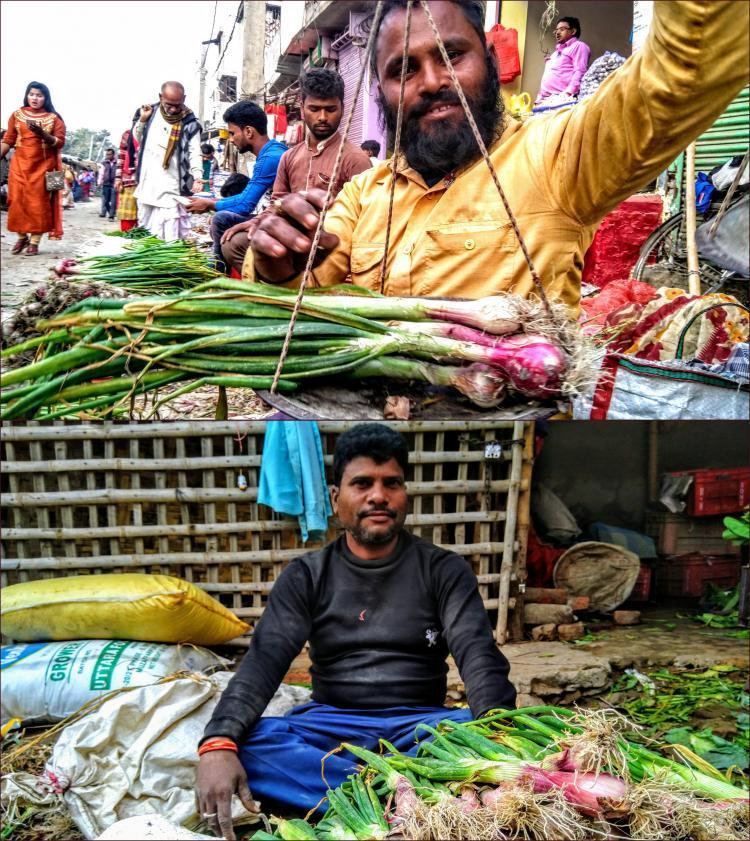
Bablu Sah and his uncle Naandlal Sah [bottom] are selling scallions or sanda piyaaz.
Each retailer pays Rs. 10 daily as street vending fee, Rs. 5 to sweeper, Rs. 15 for the private power supply and Rs. 2 to a guard. Regardless of these charges, their space is neither safeguarded by the administration nor are they protected against flash floods, which is an annual story for them, and disrupts their business for a month.
Initially, Meena Bazar was established under the royal patronage of Bettiah Raj. Its lustre degraded after new age businessmen relocated their shops elsewhere. After powerful shops were out of the scene, the administration, this reporter finds, ruthlessly cracked down on vendors and small shopkeepers some years ago. Since then, the encroachment removal drive and re-encroachment have become a regular cycle.
Retailers, who are larger in number, have not been provided any alternate space. Thus, setting up stalls on encroached land is the only way to make a living.
Markanday Prasad Gupta, 45, pays an extra Rs. 30 a day to the alleged owners of the land on which he puts up his stall. As it is a footpath, it seems that there are some ugly characters in this business. In fact, the alleged owners are locals who put bamboo enclosures on the acquired space and sell these to vegetable vendors who agree to pay the charges they demand. This makes vendors, like Gupta, spend a minimum of Rs. 60 each day. They cannot even complain to the authority which considers them encroachers and regularly evicts them. Retailers, most of them being uneducated, are not even aware of their rights.
On onion price hikes, Gupta says“no retailer wants this. This is not for us …. We were making same profit on unit weight even when the price was normal. But gross profit is losing momentum today, much against our business. Today, I could sell only 10 kg of onions out of my 50 kg stock.”
Gupta, a landless retailer, dropped out after Class 8 because of financial problems at home. His children are pursuing formal education. No retailer, this reporter talked to, had children out of school.
Two of Gupta’s children—Vikash and Nikki—are pursuing Bachelor’s in Arts in a local government college; Saloni, the youngest one, goes to a secondary school.
As this reporter prepares to leave, one customer is overheard in Gupta’s shop saying that “one should consider buying lentils over onions.”
“But onion is onion. Why are you are searching for a replacement […],” another customer adds.
Get the latest reports & analysis with people's perspective on Protests, movements & deep analytical videos, discussions of the current affairs in your Telegram app. Subscribe to NewsClick's Telegram channel & get Real-Time updates on stories, as they get published on our website.
























